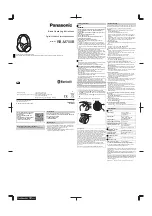
Fitting Instructions
1. Adjust headband to its lowest position. Place the headband
on top of the head.
2. Pull the cups outward and position the ear muffs over your
ears until ear is completely inside cup. For maximum protec-
tion, position smaller end of ear cup in upward position.
3. Adjust the height of the headband so that it rests comfort-
ably in desired position. Be sure the cushions are seated
firmly around the side of the head and ears.
CAUTION
• Spread the ear cups only enough to clear the ears.
• Do not reform or reshape the headband.
• Foreign objects (such as pencils) between the ear cup
and wearer’s head reduce the efficiency of the ear muff.
Remove as much hair as possible. Use glasses with
smallest temple available (cable type is best).
Information required by EPA
The level of noise entering a person’s ear, when hearing protector is worn as
directed, is closely approximated by the difference between the A-weighted
environmental noise level and the NRR.
Example:
The environmental noise level as measured at the ear is 92 dB(A). The NRR is
28 decibels (dB). The level of noise entering the ear is approximately equal to
64 dB(A) for over head position [92-28 dB(A)].
CAUTION
For noise environments dominated by frequencies below 500 Hz the C-weight-
ed environmental noise level should be used.
WARNING
Although hearing protectors can be recommended for protection against
the harmful effects of impulsive noise, the Noise Reduction Rating (NRR) is
based on the attenuation of continuous noise and may not be an accurate
indicator of the protection attainable against impulsive noise such as
gunfire. Wearing this product for protection against impulsive noise such as
gunfire may still result in hearing loss. Impulsive noise is defined as noise
levels having peaks at intervals of greater than 1 second. There may be
conditions under which impulsive noise exists and many differences in the
tolerances of various users. For this reason, there is no accepted way to
determine if any hearing protective device provides adequate protection
against impulsive noise.
The EPA has selected the NRR as a measure of a hearing protector’s noise
reducing capabilities. There is no warranty as to the suitability of the NRR as a
measure of actual protection since such protection is highly dependent on user
training, motivation, and utilization. Consult the above instructions for proper
fit. A better estimate of workplace protection can be obtained by derating the
labeled NRR of this, or any other hearing protector, by 50%.
Maintenance and Cleaning
1. Ear cushions and foam pads may deteriorate with use and should be
examined frequently for cracks, tears, etc.
2. Clean the ear muffs after each use with a lint-free cloth with mild soap (no
detergents) and warm water solution. Do NOT totally immerse ear muffs
in water. Do not use abrasive brushes or materials, which may damage the
foam pads or ear cushions. Use only cleaning agents that are known to be
safe to the wearer.
Storage
Store ear muffs in a clean and dust free place when not in use. Safety Works
recommends using the reclosable package the ear muffs came in for storage.
Instructions d’ajustement
1. Dépliez le casque antibruit. Ajustez le serre-tête à sa
position la plus basse. Mettez le serre-tête sur la tête.
2. Tirez les coquilles vers l’extérieur et placez le casque
antibruit sur les oreilles de manière à ce que les coquilles les
recouvrent complètement. Pour une protection maximale,
placez la petite extrémité de la coquille en haut.
3. Ajustez la hauteur du serre-tête de manière à ce qu’il repose
aisément à la position souhaitée. Assurez-vous que les
coussinets reposent fermement autour de la tête et des
oreilles.
MISE EN GARDE
• N’écartez les coquilles que de la largeur nécessaire pour
les placer sur les oreilles.
• Ne reformez pas ni ne reprofilez le serre-tête.
• Les corps étrangers (comme des crayons) placés entre
la coquille et votre tête réduisent l’efficacité du casque
antibruit. Retirez autant de cheveux que possible.
Utilisez des lunettes avec des branches aussi minces
que possible (le type cordon est le meilleur).
Renseignements requis par l’EPA
Le niveau de bruit entrant dans l’oreille d’une personne, lorsque le
protecteur auditif est porté correctement, peut être fixé approximativement
en soustrayant du NRR (indice de réduction du bruit) le niveau de bruit
ambiant pondéré en dB(A).
Exemple :
Le niveau de bruit ambiant tel que mesuré au niveau de l’oreille est de 92
dB(A). Le NRR est de 28 décibels (dB). Le niveau de bruit entrant dans l’oreille
est d’environ 64 dB(A) pour la position sur la tête [92-28 dB(A)].
MISE EN GARDE
Dans le cas d’un bruit ambiant dont les fréquences principales sont inférieures
à 500 Hz, utilisez le niveau de pression acoustique pondérée en dB(C).
Pro Series Ear Muffs
Casques antibruit Pro Series
Auriculares Pro Series
P/N SWX00334
2002038 Rev 0 1511




















